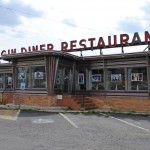As the recession passes all too slowly into memory, building activity is picking up even in the most distressed communities, including Camden. Renovations of housing are proceeding around Cooper Hospital, work on the impressive Kroc Center in Cramer Hill is coming along nicely, and a new charter school located off Linden Street seemed to appear overnight.
 Even as these new opportunities opened up, headlines captured the end of an era with the demolition, after many delays, of the historic Sears building on Admiral Wilson Boulevard and the coincidental revelation that the Elgin Diner on Mt. Ephraim Avenue would also be coming down before long. Such demolitions often signal progress, as abandoned properties give way to new uses suitable to contemporary needs. In these two cases, a much larger question arises: what is the vision for post-industrial Camden?
Even as these new opportunities opened up, headlines captured the end of an era with the demolition, after many delays, of the historic Sears building on Admiral Wilson Boulevard and the coincidental revelation that the Elgin Diner on Mt. Ephraim Avenue would also be coming down before long. Such demolitions often signal progress, as abandoned properties give way to new uses suitable to contemporary needs. In these two cases, a much larger question arises: what is the vision for post-industrial Camden?
The Sears building, when built in the 1920s was intended to serve as part of the gateway to the city, boosted by the opening of a bridge over the Delaware River to Philadelphia. Not everything that was expected of the area materialized, but Sears remained for many years a magnet to shoppers from the region. In a new era, the developers of the property, Camden’s major business Campbell Soup, wants to develop an office park, one that would both look like and operate like the complexes located in suburban Mount Laurel. Such a complex, operating 9 to 5 would draw people from the region into Camden, but its isolation from the rest of the city would not encourage further interconnections with existing places of business in the city. It would, like much of existing suburban development, operate as a pod within the city, but not be part of its 24-hour-a-day life.
 According to recent news reports, the Elgin Diner, which also drew customers from nearby suburbs into the city, would give way to a dollar store, serving largely local customers whose limited incomes might incline them to look for bargains they might not otherwise find nearby. In the process, not only a distinctive building would be lost, but also a place where people from both the city and the nearby suburbs could get a meal at reasonable prices and feel a sense of community at the same time.
According to recent news reports, the Elgin Diner, which also drew customers from nearby suburbs into the city, would give way to a dollar store, serving largely local customers whose limited incomes might incline them to look for bargains they might not otherwise find nearby. In the process, not only a distinctive building would be lost, but also a place where people from both the city and the nearby suburbs could get a meal at reasonable prices and feel a sense of community at the same time.
Among Camden’s highest priorities for recovery from a slide of half a century is not just economic development, but the capacity to reintegrate into the larger region. As long as Camden is perceived as starkly different from its surrounding communities, it will continue to be demonized at worst and certainly avoided by many. Carving up the city into distinct destination zones—office parks for suburban employees, dollar stores for poor residents—doesn’t do much to advance regional reintegration. Surely, there will be those who will celebrate the demolitions of these structures as part of the city’s progress. The rest of us should be pressing for uses that do more to advance not just profit but a more comprehensive approach to enhancing Camden as a vital part of the South Jersey region.